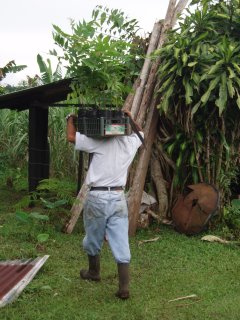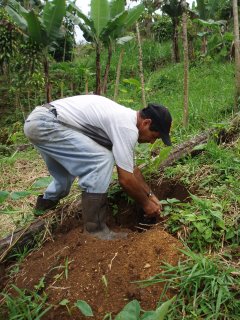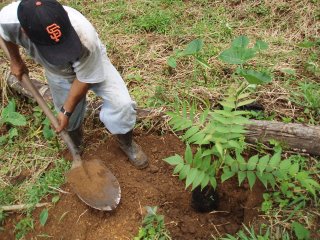 La Cunicula (the name for the weird weather period in July and August) is over and its time to plant. We have 120 Nogales (Black Walnut) bagged-up, ready for distribution. William Mendez (pictured here) came by this morning to pick up his order for 33. ¿Que vale? After numerous reminders that we are providing a free service to the community, he still asks me how much they cost. He was happy once again to hear that they were free. Tomorrow I’m going over to help William put them in the ground. We will be reforesting the riparian (river ecosystem) hillside on the south part of his farm. These fast growing species will grow tall and extend their roots into the bank of the river, helping to combat erosion, while the leafy canopy will provide shade protecting the soil from too much sun exposure.
La Cunicula (the name for the weird weather period in July and August) is over and its time to plant. We have 120 Nogales (Black Walnut) bagged-up, ready for distribution. William Mendez (pictured here) came by this morning to pick up his order for 33. ¿Que vale? After numerous reminders that we are providing a free service to the community, he still asks me how much they cost. He was happy once again to hear that they were free. Tomorrow I’m going over to help William put them in the ground. We will be reforesting the riparian (river ecosystem) hillside on the south part of his farm. These fast growing species will grow tall and extend their roots into the bank of the river, helping to combat erosion, while the leafy canopy will provide shade protecting the soil from too much sun exposure.  On Wednesday I will deliver another 30 Nogales to Roberto Jiménez, who has part of his land under restoration. A farmer with decades of experience, Roberto said he really loves the Nogales. He told me yesterday that the majority of trees that were planted for reforestation have died because they were so little when they were planted. He was happy to hear that our Nogales are 2-3 feet high and well established. The roots are actually breaking through the bottom of the bag. Roberto asked me if I could help plant the trees because he is still recovering from his kidney stone operation. "Por supuesto", of course, I told him.
On Wednesday I will deliver another 30 Nogales to Roberto Jiménez, who has part of his land under restoration. A farmer with decades of experience, Roberto said he really loves the Nogales. He told me yesterday that the majority of trees that were planted for reforestation have died because they were so little when they were planted. He was happy to hear that our Nogales are 2-3 feet high and well established. The roots are actually breaking through the bottom of the bag. Roberto asked me if I could help plant the trees because he is still recovering from his kidney stone operation. "Por supuesto", of course, I told him. Since Finca Project has begun distribution, everyone has been asking how much the saplings cost. After reminding people that they are free, they began "selling" like hotcakes. I paused to think about the consequences of our project. We obviously want to get as many trees out into the community as we can, BUT it wont do much (long-term) good to give away trees to farmers who are going to cut them down in 5 or 10 years when they have some sort of economic value.
 We also don’t want to undercut local nursery business by dissolving the market for hardwood, fruit, and shade trees. The closest substantial nursery is in San Vito, which is half an hour away, and I´m sure there are smaller ones all around. This calls for market research. As for creating incentives to alleviate pressures to cut down trees, well, that’s gonna be tough to figure out. Some things are out of our control, and finding community-level solutions to problems caused by global economic structures will take creativity, ingenuity, and commited community interest. For now, we will begin to formalize the distribution process by enrolling farmers in our micro-reforestation projects, which involves a meeting to review guidelines for participation. This will, at least, ensure understanding of our project and reinforce the specific beneficial details of micro-reforestation in general.
We also don’t want to undercut local nursery business by dissolving the market for hardwood, fruit, and shade trees. The closest substantial nursery is in San Vito, which is half an hour away, and I´m sure there are smaller ones all around. This calls for market research. As for creating incentives to alleviate pressures to cut down trees, well, that’s gonna be tough to figure out. Some things are out of our control, and finding community-level solutions to problems caused by global economic structures will take creativity, ingenuity, and commited community interest. For now, we will begin to formalize the distribution process by enrolling farmers in our micro-reforestation projects, which involves a meeting to review guidelines for participation. This will, at least, ensure understanding of our project and reinforce the specific beneficial details of micro-reforestation in general.
So long from the Farm,
Pura Vida
Brendan

2 comments:
These are some interesting questions, but with your problem solving skills this should be a soild challenge for the team. Keep up the good work. Look forward to seeing the progress over the next few years.
Rizzle
Before we upright creatures came along with our diggin' sticks, the forest creatures searched each tree and bush for seeds to eat. Those without edible seeds had to figure out other solutions for survival. You nutcases have chanced on your own solution. When these sprouts get large enough they will support a growing number of creatures that will rush around planting more nuts that will become new sprouts too small to harvest.
vive nuts!
Post a Comment